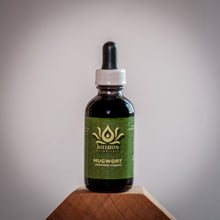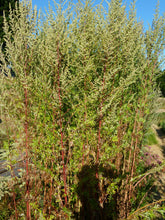An excellent nervine. Used for insomnia and nervousness. Kills parasitic worms internally. Mugwort is considered feminine in nature and has been linked throughout history as remedy for women’s health. It promotes suppressed menses. And is useful for young women just starting menses. Believed to increase fertility and used in the treatment of liver disorders and as a digestive aid (digestive bitter). Drink infusion before and/or after eating to promote digestion. Promotes sweating and is known as a dream inducer.
Made with fresh harvested leaf.
Bottle: 50ml
-----------------------------------
Would you like to know more? Below you can find an excerpt from our book "Medicinal Perennials to Know and Grow"
Mugwort is native to Northern Europe and Asia and can also be found in many parts of North America. It grows up to 12 feet in our gardens and self-sows readily. It has angular reddish stems; the bitter-tasting leaves have a sage-like aroma and they have a dense cottony underside.
When it is not in flower, mugwort somewhat resembles motherwort and it shares some similar properties. Both are considered excellent nervines for treating insomnia, nervousness, hysteria and shaking. Mugwort, like motherwort has strong emmenagogic properties that can be used to lessen menstrual cramps and induce menstruation. It should be avoided during pregnancy and breast feeding.
Herbalists use the tea or tincture to treat liver and stomach disorders and First Nation North Americans brewed the tea for colds and flus, bronchitis and fevers; they also used the dried leaves for smudging.
Sometimes called St. John’s Plant, legend has it that John the Baptist wore a girdle of mugwort in the wilderness. It was believed to preserve the wayfarer from fatigue, sunstroke, wild beasts and evil spirits.
Mugwort has been used to kill parasitic worms, as a digestive bitter and to promote sweating. Leaves placed under pillows at night are said to induce vivid dreams.
In traditional Chinese medicine, Artemisia vulgaris is used in a therapeutic technique called moxibustion. A dried cottony mass of it is burned directly on the skin to stimulate the immune system, promote circulation and to relax underlying nerves. It is specifically indicated for conditions associated with coldness and deficiency.
Romans planted mugwort by the roadsides so marching soldiers could put the leaves in their sandals to relieve aching feet.
Mugwort is commonly used in cooking to flavour many foods and beverages, including fish, meat dishes, desserts, pancakes, soups, salads and beer. It was used in Europe to flavour beer long before hops were employed.
Mugwort seeds are tiny and it is best to start them in potting soil to be transplanted out after about 8 weeks. Mugwort is known to repel moths and other insects. It is a hardy, attractive and carefree plant once established.






